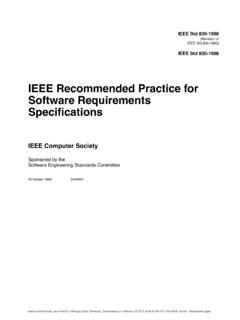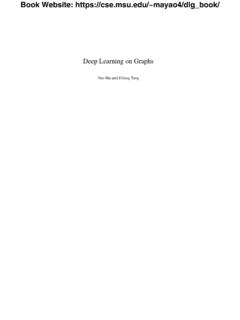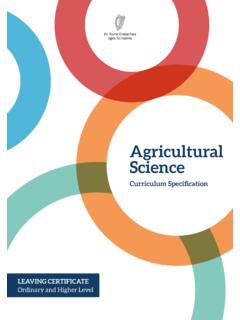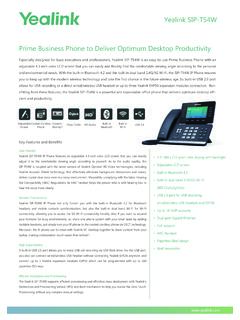Transcription of Software Requirements Specification (SRS) Book E …
1 Template based on IEEE Std 830-1998 for SRS. Modifications (content and ordering of information) have been made by Betty Cheng, Michigan State University (chengb at ) Software Requirements Specification (SRS) Book E-Commerce System (BECS) Authors: Andrew Blossom Derek Gebhard Steven Emelander Robert Meyer Customer: Mr. Borzoo Bonakdarpour Instructor: Prof. Betty Cheng 1 Introduction The Software Requirements Specification is designed to document and describe the agreement between the customer and the developer regarding the Specification of the Software product requested [5]. Its primary purpose is to provide a clear and descriptive statement of user Requirements [5] that can be used as a reference in further development of the Software system. This document is broken into a number of sections used to logically separate the Software Requirements into easily referenced parts. This Software Requirements Specification aims to describe the Functionality, External Interfaces, Attributes and Design Constraints [4] imposed on Implementation of the Software system described throughout the rest of the document.
2 Throughout the description of the Software system, the language and terminology used should unambiguous and consistent throughout the document. Purpose Defining and describing the functions and specifications of the Book E-Commerce System (BECS) is the primary goal of this Software Requirements Specification (SRS). This Software Requirements Specification illustrates, in clear terms, the system s primary uses and required functionality as specified by our customer. The intended audience of this document is our primary Book E-Commerce System customer: Mr. Borzoo Bonakdarpour, the CSE435 instructor Dr. Betty Cheng, the fall semester 2007 CSE435 Group 4 members, as well as the other students attending CSE435 that will require access to such documentation. Template based on IEEE Std 830-1998 for SRS. Modifications (content and ordering of information) have been made by Betty Cheng, Michigan State University (chengb at ) Scope The Software system being produced is called Book E-Commerce System or BECS.
3 It is being produced for a customer interested in selling books via the Internet. This system is designed to provide automation support [2] for the process of placing books for sale on the Internet and facilitating the actual sale. This system is largely cross-platform and is available to anyone using the Computer Science Department s provided computer resources in the MSU Engineering Building. The system will be run on a central server with each user having a remote user interface through a web browser to interact with it. The Book E-Commerce System will allow any user to create an account to become a customer. The customer, through the process of account creation, will have the option to become a member of the site. The system will allow customers to browse, search, select, and add books to a shopping cart. Then, provided they have books in their shopping cart, check out books in shopping cart and decrement the stock that the inventory the system maintains. The BECS also allows a manager to manage the inventory with full create, retrieve, update and delete (CRUD) functionality with regards to books in the system.
4 It will also allow, on an inventory wide basis, customers and managers to interact with a promotion system that handles percentage-off promotions that can be applied to member s orders. This interaction includes the creation (by managers) and the application to orders (by customers) of the promotions. The BECS has full email capabilities; the automated email functionality will be used to send promotions to members of the system as well as provide the managers with low-stock notifications. The BECS will have numerous constraints on what it can do. The system will not have full credit-card processing capabilities. It will not allow managers to be customers. The manager will be a hard-coded user and only a single manager will exist. There will be no actual book ordering and order completion, however the system will provide the customer with a receipt and it will log the transaction details. The system will not allow multiple promotions to be added to a single shopping cart nor will it allow a customer to add more than one of each item to their cart.
5 The system also will not allow users to retrieve passwords or edit their user details. Definitions, acronyms, and abbreviations BECS Book E-Commerce System Barcode A unique identifier assigned to single items Book An instance of an Item that has these additional attributes: Title, Author Button A user interface element that allows a User to click and inform the system to take an action Checkbox A user interface element that allows a User to inform the system that he/she selected a particular item Checkout The process a Customer goes through to purchase an Item CRUD Create, Retrieve, Update, Delete Customer A person that is a user of the system but has created an account Inventory An object that holds items available for purchase by the Customer Item An individual entity in the inventory which has several descriptive attributes: Template based on IEEE Std 830-1998 for SRS. Modifications (content and ordering of information) have been made by Betty Cheng, Michigan State University (chengb at ) Barcode, Price, Reorder Threshold, Stock Manager A single person that has the ability to create, retrieve, update and delete items in the store.
6 This person cannot simultaneously act as a Customer and Manager. Member A person that is a customer of the system and has requested to be sent promotions Promotion An item-wide percentage-off price discount applied to a Member's shopping cart Reorder The system process that automatically orders new stock of an item Reorder Threshold The numeric value of an item's stock that must be reached before the system will order additional quantities of the item Session The time which a User is actively using the system Shopping Cart An object that lists a Customer's selected Items, their applied promotions and gives them an option to check out SRS Software Requirements Specification Stock The quantity of any particular item the inventory has on hand Text Box A user interface element that allows a User to input text to the system Transaction The information related to a customer's purchase that is logged User The person who operate the Software product. Organization This Software Requirements Specification document is divided in to multiple subsections.
7 The first section includes explanations of the Purpose, Scope and Organization of the document. The first section also handles the description of project-specific words, acronyms and abbreviations that will be used in the document. The second section of the document is separated into the following five different sections, each detailing specific details of system uses and their corresponding actions: Product Perspective, Product Functions, User Characteristics, Constraints, Assumptions and Dependencies, Apportioning of Requirements . The third section is an enumerated listing of all of the Requirements described for this system. The fourth section encompasses all of the Use-case, Sequence, State and Class diagrams that model the system. In the fifth section there exists a Prototype of the system along with a sample scenario that graphically describes the use of the system. The sixth section contains a listing of all related reference materials used in this document. The seventh and final subsection is dedicated to providing a point of contact for any viewer of this document.
8 2 Overall Description This section includes details about what is and is not expected of the BECS system in addition to which cases are intentionally unsupported and assumptions that will be used in the creation of the BECS system. Template based on IEEE Std 830-1998 for SRS. Modifications (content and ordering of information) have been made by Betty Cheng, Michigan State University (chengb at ) Product Perspective BECS is an online bookstore website which supports a number of functions for both the consumer and store's management. The website must be available to anyone using the Computer Science Department s provided computer resources in the MSU Engineering Building and as such must work correctly in both Internet Explorer and Mozilla Firefox. As stated by the customer, there are no hardware or Software Requirements beyond these including, but not limited to, memory or specific Software packages that need to be utilized nor Software packages that need not be utilized.
9 Product Functions BECS will provide a number of functions; each is listed below. Maintain data associated with the inventory (a collection of books) A book has a title, author and price The inventory also keep track of the stock/quantity of each book Maintain records for many customers A customer can be either a member or non-member. A customer has a username (unique across all users), password (no restrictions), email address (no restrictions), and postal address (unverified.) Anyone may sign up for a customer account. Allow any customer to become a member. Show a listing of available books Books are to be displayed in ascending alphabetical order by title. Each book will list the following from left to right Title Author Price Allow customers and managers to log in and out of the system. Users (both customers and the manager) will be logged out if inactive for 30 minutes. Shopping cart Anyone is able to add one or more books to the shopping cart.
10 The shopping cart does not need to allow multiple copies of any book. Checkout Checkout is only available to logged-in customers. A user that is not logged in as a customer is given a chance to log in. Member customers may enter a promotion code. Only one promotion code may be used per purchase The promotion is a fixed percentage discount that is to be applied to an entire order. The discount is specified by the manager at the time of the promotion s creation or most recent update/edit. Collect a 16-digit credit card number from the customer Log/record the transaction Allow manager to specify a stop-order for a book Each book has its own stop-order status either on or off. Details of its use are involved in the following feature. Notify manager when books need to be reordered When the quantity a book falls below a threshold, the manager is notified that the book Template based on IEEE Std 830-1998 for SRS. Modifications (content and ordering of information) have been made by Betty Cheng, Michigan State University (chengb at ) needs to be reordered.











